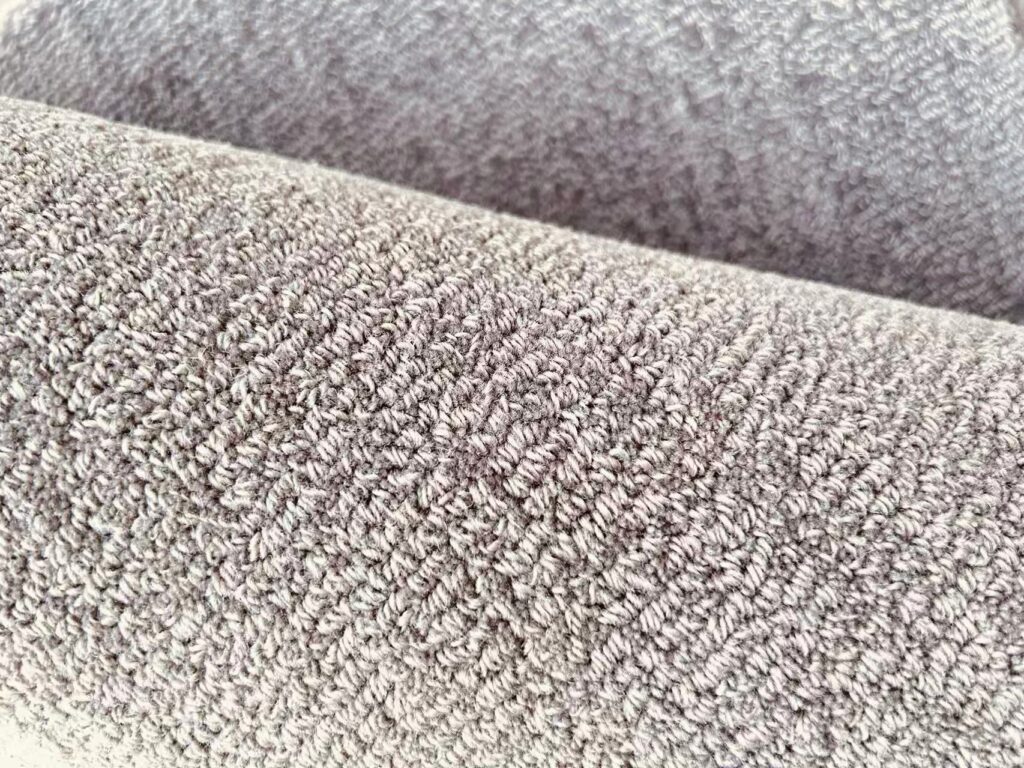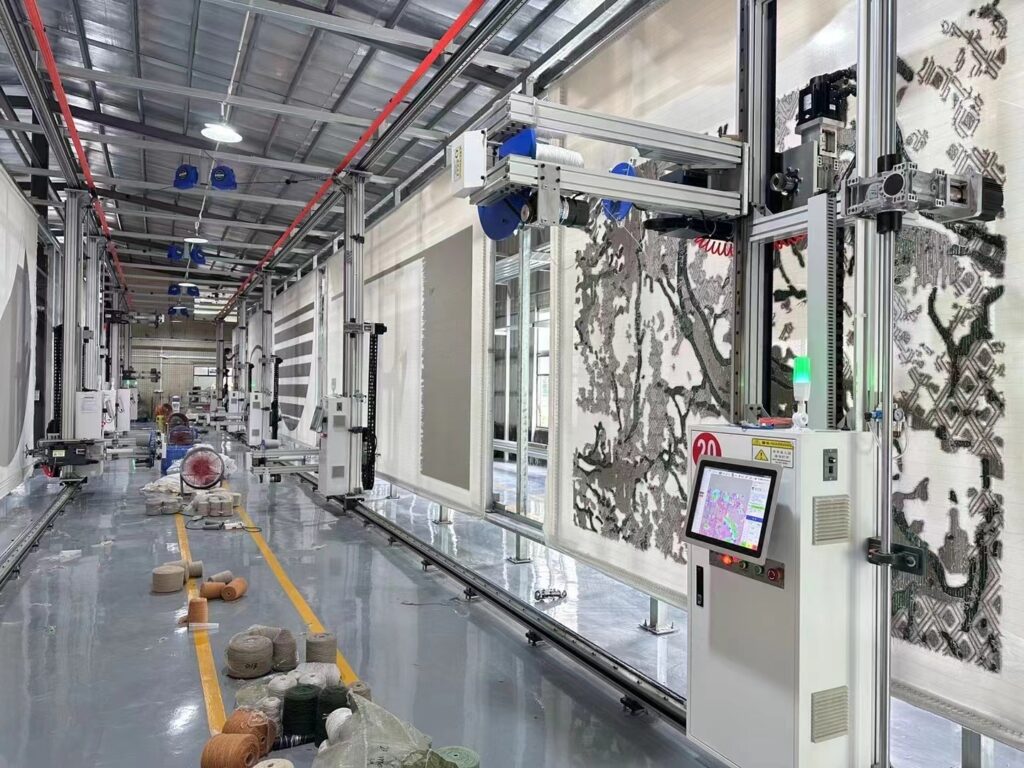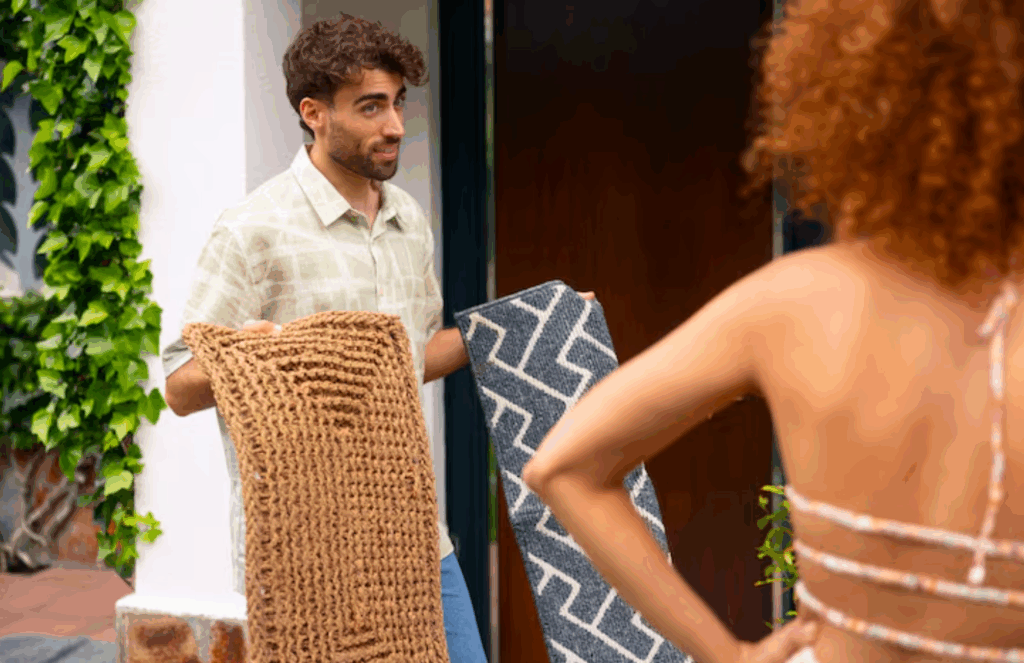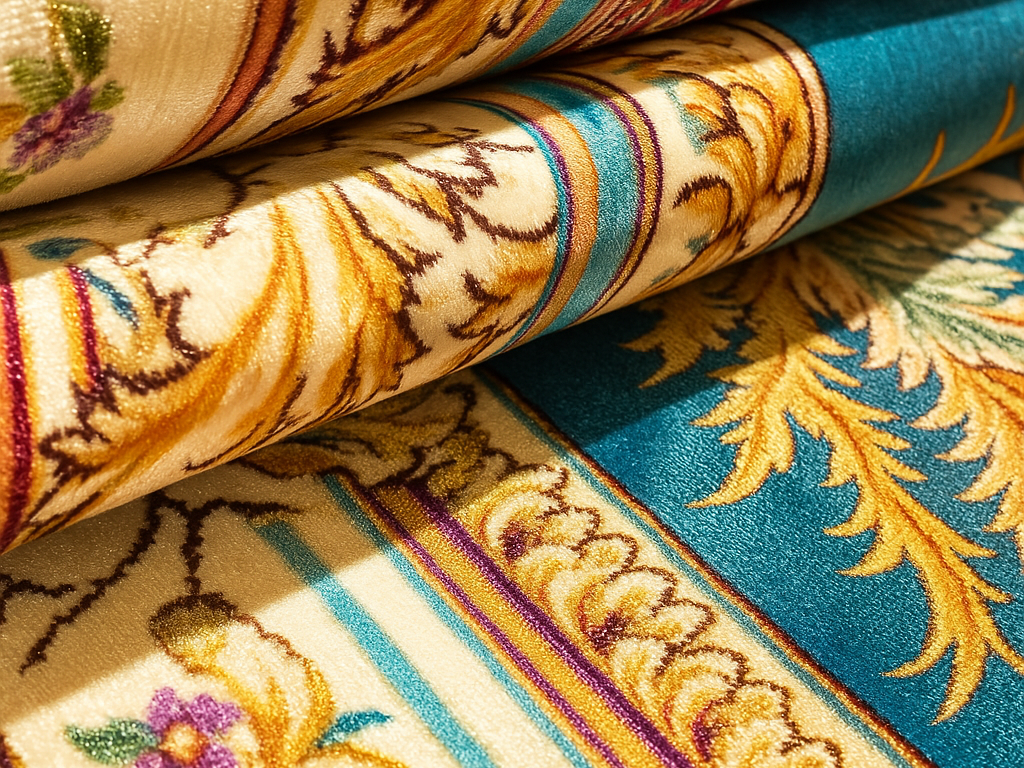When you step into a room, few details shape its character like a rug does. The texture underfoot, the way light plays off its surface, and even the imperfections in its weave all tell a story. But behind every rug lies a craft — and how that rug is made defines its quality, price, and longevity. Among the most common constructions in the world of wool rugs are hand-knotted, hand-tufted, and machine-made.

If you’ve ever wondered why some rugs cost thousands while others go for a fraction of that, or how to choose the right one for your home, this guide from Valhak will walk you through everything — from the looms of traditional weavers to the efficiency of modern machines.
1. What is a Hand-Knotted Wool Rug?
A hand-knotted rug is the most traditional, labour-intensive form of rug construction. In this process, the rug maker (or team of makers) ties individual knots—one by one—onto the warp threads of a loom. After each row of knots, wefts are beaten down to secure them, and the process continues row by row until the rug is complete.
These knots may be of different types (e.g., Persian or Turkish), and what really makes the difference is the density of knots per square inch—higher knot counts mean finer detail and generally better durability. The pile that you see is formed by the cut ends of those knots.
The materials used are typically natural: wool is very common (given its resilience, softness and natural stain resistance thanks to lanolin), sometimes with silk accents or cotton foundation.
Characteristics
- Because each knot is tied by hand, no two rugs are exactly identical—even in the same pattern. Slight imperfections (variations in colour, size, shape) are part of the charm.
- The back of a hand-knotted rug reveals the design almost as clearly as the front: you will see the individual knots and the warps/wefts.
- There is generally no “glued-on” backing or latex layer; the structure is entirely integral.
- Because of the materials and method, hand-knotted rugs tend to be thicker, heavier, and more expensive—but also more durable (often decades or even generations) if cared for properly.
From a Value & Lifestyle Perspective
If you see a wool rug labelled “hand-knotted,” you are effectively acquiring an artisan item—almost a piece of textile art. For the homeowner who values the longer-term investment, the physical feel (natural wool yarns, density), and the aesthetic richness (intricate design, unique character), hand-knotted is top tier.
On the flip side: because it’s labour-intensive and uses high-quality materials, the price will be higher. Also, the repair, cleaning or restoration of these rugs may require specialist attention.
When to Choose Hand-Knotted
- In a formal living room, dining room or main space that you expect to use for many years.
- If you value heirloom potential, uniqueness, natural wool, and are okay with higher investment.
- If you want the best durability, especially under moderate to high traffic.
2. What is a Hand-Tufted Wool Rug?
A hand-tufted rug is somewhat halfway between handmade and mechanised production. The process begins with a canvas or fabric stretched over a frame. A “tufting gun” or hand-operated tool is used to push (or punch) wool yarns (or other fibre strands) through that backing or substrate. Then a latex or adhesive layer is typically applied on the back, and a secondary backing fabric is attached to lock everything in place.

Unlike a hand-knotted rug, the individual knot-tying process is replaced by tufting loops or pile insertion. Some looped piles remain, some get sheared to form a cut pile. Because of this, the volume of hand labour is much less than in a hand-knotted rug.
Characteristics
- The surface can look quite similar to hand-knotted at first glance (especially from a distance), since material (e.g., wool) and pile height may overlap.
- The back will usually have an adhesive or latex layer, and a backing fabric—so you will not see individual knots in the same way.
- Because the production is faster and less labour-intensive, cost tends to be lower than hand-knotted.
- Durability is less (though still respectable) compared to hand-knotted—often it is said a good hand-tufted rug may last 5-20 years under moderate use.
- Design flexibility is high: because you’re not tying every knot, the production can allow for more dramatic colour changes, patterns, perhaps quicker turnover.
From a Value & Lifestyle Perspective
Hand-tufted wool rugs offer a good “mid-point” between economy and quality. For a homeowner who wants the feel of wool, the look of texture and artistry, but at a lower investment, hand-tufted is often a smart choice. It’s ideal when you want the rug to look good and serve a space for a decent period but don’t expect lifetime (or generational) usage.
On the trade-off side: because of the backing and tufting process, they cannot usually match the longevity or investment value of hand-knotted. Also, cleaning can require caution (you don’t want to damage the backing or cause tufts to loosen).
When to Choose Hand-Tufted
- In a living room, bedroom, or area where you want style and comfort but aren’t committing to decades of use.
- If you love natural wool but are more budget-sensitive than a full hand-knotted investment allows.
- When you may wish to change décor more often (so a mid-life rug is acceptable).
3. What is a Machine-Made Wool (or Wool Blend) Rug?
“Machine-made” is a broad term, but in the rug context it generally refers to rugs produced on automated or power looms, where the weaving, looping or tufting processes are carried out with minimal hand-labour. This includes machine-loomed, power-loomed, or machine-tufted rugs.

In many cases, fibres used may be synthetic (polypropylene, polyester, nylon) though wool (or wool blends) may be used—depending on price. What distinguishes the machine-made process is: uniformity, efficiency, large volume production, consistent dimensions, and often cheaper labour and materials.
Characteristics
- The design and pattern are often perfectly symmetrical; edges are very straight; the back is uniform and may not clearly show individual knots.
- Because of the mechanised processes, these rugs are typically less expensive than either hand-knotted or high-end hand-tufted.
- Durability varies significantly depending on materials and construction quality, but as a general rule machine-made rugs offer good value for moderate use—but rarely match the lifespan of a quality hand-knotted piece.
- Maintenance is generally easier (especially with synthetics), and production allows for broader design and trend responsiveness. They may not have the same artisanal uniqueness or heritage value.
From a Value & Lifestyle Perspective
For many modern homes, machine-made wool (or wool-blend) rugs are perfectly acceptable—especially in rooms with moderate traffic, children, pets, or where cost is a significant consideration. They give you the look of a rug, texture underfoot, and design flexibility.
However: if your objective is a long-term heirloom, a true artisan piece, or you value natural materials and craftsmanship as a key component of the purchase, machine-made may not offer the same “investment” quality.
When to Choose Machine-Made
- In a higher traffic space (entry-way, family room, kids’ playroom) where cost and ease of replacement are important.
- If you’re working on a budget but still want wool (or wool-blend) rather than purely synthetic.
- If you plan to replace or change rugs more frequently as trends evolve.
4. Side-by-Side Comparison: Hand-Knotted vs Hand-Tufted vs Machine-Made
| Feature | Hand-Knotted | Hand-Tufted | Machine-Made |
| Labour & Time | High: many knots tied individually; months of work. | Moderate: tuft gun + frame + backing; faster production. | Low per unit: automated looms, large batch production. |
| Materials (typical) | Natural fibres (wool, sometimes silk) on wool/cotton foundation. | Can be natural (wool) or blended; backing often includes latex/adhesive. | Often synthetic fibres (polypropylene, polyester) though wool versions exist; backing may be heavy. |
| Appearance & Character | Unique, slight irregularities, artisan feel; knots visible from back. | Good surface look, backing visible, less uniqueness; loops or cut pile based on process. | Uniform look, perfect symmetry, very consistent; back often shows grid or synthetic structure. |
| Durability / Lifespan | Highest: decades or more possible with good wool, dense knotting. | Mid-tier: 10-20 years typical under moderate use. | Varies: quality dependent; typical lifespan may be shorter under heavy use. |
| Cost & Value | Highest upfront cost; potential investment; heirloom value. | Moderate cost; good value; less investment potential. | Lower cost upfront; good value for many uses; limited resale/heirloom value. |
| Ideal Use | Main formal spaces, long-term home, high-quality décor. | Bedrooms, living rooms, design-aware homes but moderate budget. | Everyday rooms, high traffic, rental properties, changeable décor. |
| Maintenance Notes | Natural wool, may need specialist cleaning; can often be repaired. | Backing and tufts may require caution; easier cost but less robust. | Often easiest to clean (synthetics), but may show wear sooner. |
5. Why Material (Wool) Still Matters
Since this conversation is specifically about wool rugs (and our brand Valhak focuses on wool), it’s worth emphasising how the material interacts with construction.
- Wool is naturally durable, resilient, and has built-in lanolin (which provides natural stain resistance). Hand-knotted wool rugs especially benefit from this.
- In hand-knotted rugs, the quality of the wool and the knot density both play major roles in longevity and appearance.
- In hand-tufted or machine-made rugs, if wool is used, that’s a plus—but the construction still imposes limits on lifespan; the backing and tufting process (or power-looming) may reduce performance.
- Synthetic fibres (often in machine-made rugs) are fine for certain uses but may lack the natural comfort, patina, and aging benefit that wool offers.
So: when you see a “wool rug” labelled hand-tufted or machine-made, you’re getting the benefit of the material, but not necessarily the full benefit of artisan construction.
6. Key Buying Tips for Hand-Knotted, Hand-Tufted, Machine-Made Rugs
When you’re investing in a wool rug—whether it’s hand-knotted, hand-tufted or machine-made—the construction matters every bit as much as the material. As you shop, keep in mind the true value comes from matching the construction to your space, lifestyle, and expectations. Below we break out specific buying guidance for each type, expanding on subtle distinctions and practical questions you should ask.

Hand-Knotted Wool Rugs
These are the premium tier in wool rugs. If you’re seeking longevity, uniqueness, and craftsmanship, this is the area to focus on.
What to look for:
- Examine the back: A genuine hand-knotted rug will show the pattern of the design quite clearly from the backside, and the fringe is part of the warp foundation rather than sewn on.
- Knot density / knot count: Higher knot count means more detail, finer weave, and often greater durability. But note—knot count isn’t the only metric: the quality of wool, dyeing, and foundation also affect performance.
- Wool quality and dyes: The wool should feel springy, not flat. Dyes should be colour-fast and rich rather than faded or overly slick.
- Measure size properly: Before bringing it home, mark the floor or use masking tape to map how much space your rug will cover. The right size is just as important as the right quality.
- Consider origin and craftsmanship: Regions known for hand-knotting (Persia/Iran, India, Turkey) carry legacy and in many cases, better resale or heirloom potential.
- Budget realistically: Because of the labour involved, expect a higher investment. If the price seems too low for a “hand-knotted” rug, investigate further.
- Ask about backing/Foundation materials: Hand-knotted pieces typically have cotton or wool foundations, no heavy glue or backing sheets.
- Authenticity and ethics: Work with a trusted retailer who transparently shares origin, how artisans are compensated, and materials used.
When this type is the choice: For a formal living room, a space you expect to keep long-term, or as a piece you might pass down. With proper care, these rugs can last generations.
Hand-Tufted Wool Rugs
Hand-tufted rugs sit in a valuable middle ground — they offer the look and feel of wool artisan rugs, but at less cost and with faster production. That said, there are some specific things to check so you know what you’re buying.
What to look for:
- Check the backing: Hand-tufted rugs will often have a fabric backing over a latex/adhesive layer, since the yarn is punched in rather than individually knotted. That construction has trade-offs.
- Pile quality and construction: Make sure the pile is dense, the wool is good quality, and the stitching/tufting appears even. Some cheaper hand-tufted rugs may use thinner wool or less precise finishing.
- Avoid heavy adhesive issues: Because latex or glue is used in many tufted rugs, be cautious about placement (avoid very damp zones, avoid heavy furniture directly on it for long periods, as the backing may weaken).
- Size and high-traffic suitability: Hand-tufted rugs work well for moderately trafficked areas. If you expect extremely heavy foot traffic, you may accept a shorter lifespan than a hand-knotted piece.
- Design versatility: With tufting, more design options can be available at lower cost than hand-knotted, giving you flexibility in colours and patterns.
- Check materials: Even though tufted, insist on 100% wool (if that’s your preference) rather than wool blends or cheaper synthetics. Wool brings the resilience and texture we trust.
- Trust your senses: Smell, feel, inspect — if a tufted rug smells strongly of chemicals or the backing looks brittle or puckered, it could be lower quality.
When to pick hand-tufted: Ideal for areas like bedrooms, home offices, family rooms — where you want warmth, pattern, comfort and good value, but you don’t necessarily need jewellery-box investment level.
Machine-Made Wool or Wool-Blend Rugs
Machine-made rugs offer affordable access to wool (or wool blends) with great variety in pattern and scale. They serve many homes well — but like any product, the key is to buy smart.
What to look for:
- Identify the real material: If labelled “wool blend,” check the ratio: more wool = better feel and durability, but blending with synthetics (polypropylene, nylon) may reduce cost and durability. According to rug-buying guides, natural fibres are the “good” category.
- Backing and finish: Machine-made rugs often have a uniform backing, edges machine-serged, fringe sewn on rather than part of foundation. Look for quality finishing.
- Pile density / weave tightness: Even with machine looms, tighter weave and higher pile count mean better quality. Although knot count isn’t used the same way, you want to feel the rug is “substantial”.
- Durability vs. budget expectation: Recognize that machine-made rugs may not last as long as hand-knotted. But they can be excellent for rooms where you expect possible replacement in 5-10 years.
- Underline your usage: For rental homes, kids’ rooms, or high-traffic zones where you’d rather replace than preserve for decades, machine-made makes sense.
- Look for wool content if you want premium feel: Even machine-made wool rugs (rather than full synthetic) will give you more warmth, natural texture, and resilience than pure synthetics.
- Check for return policy, warranties and brand reputation: Since production is more standardized, you may expect consistent quality and clearer guarantees.
- Size and placement considerations: For areas like entryways or hallways, machine-made is often the most practical choice — but ensure you pick dimensions and pattern that won’t overwhelm the scale.
When this type is sensible: Entryways, corridors, kids’ rooms, rental homes or any space where you want the aesthetic of wool but are more focused on practicality and budget.
Cross-Type “Smart Questions” to Ask When Buying
Regardless of which construction you choose, here are universal questions to help you assess value and suitability:
- What size will fit the room properly? (Consider furniture layout, traffic zones, lighting.)
- What is the wool source? Is it New Zealand, Australian, or regional? What quality grade?
- How was the rug dyed? Are the colours stable (non-bleeding) and do they work in your home’s lighting?
- What is the rug’s backing or foundation? (Especially important for tufted/machine-made.)
- What kind of warranty or guarantee does the retailer offer? What about returns?
- How will the rug be maintained? Will it lie flat, will furniture shift it, will traffic crush the pile?
- Is the retailer transparent about manufacture and ethical sourcing?
- What is the long-term plan? Do you expect to keep the rug 20+ years, or are you thinking short-term, flexible décor?
- Will it be exposed to sunlight, moisture, pets or heavy foot traffic? Choose accordingly.
- Does the rug work with a rug pad? (Especially for machine-made or tufted to enhance lifespan.)
- How will the rug look over time? Consider colour fading, pile flattening, backing wear.
7. Real-World Scenarios: Which to Choose for Which Room?
Let’s apply these categories to typical home scenarios to show how the decision may play out.
- Formal living room or main seating area in a long-term home You have a house you plan to live in for many years, maybe even decades. Traffic is moderate to high, you want something that will age gracefully and be part of your home character. → Opt for hand-knotted wool. The higher upfront cost becomes justified by the longevity and the fact that this will be a centerpiece.
- Bedroom or secondary lounge where design is important but budget is more constrained You want good material (wool), nice look, but don’t want to spend as much as a top-tier piece. Traffic is moderate, you may want to switch décor in a few years. → Hand-tufted wool works well here—good compromise between cost and quality.
- Family room, children’s play zone, or designer rental / staging property You expect spills, heavy use, possibly change in décor soon. Primary concern is value and practicality. → Machine-made (wool or wool-blend) offers utility. You get design, texture, and a reasonable lifespan without king-level cost.
8. Why Valhak Recommends (and Offers) Each Construction Appropriately
At Valhak, our aim is to match you not only with a beautiful wool rug but one whose construction suits your long-term goals. Here’s how we position our offerings:
- Signature Collection (Hand-Knotted Wool): For clients seeking something lasting, elegant, and investment-worthy. We emphasise dense knotting, premium wool and craftsmanship.
- Contemporary Collection (Hand-Tufted Wool): For design-forward spaces where you want wool and style but at a more accessible budget.
- Everyday Collection (Machine-Made Wool-Blend / Wool Options): For functional yet attractive wool rugs that allow flexibility and value.
In every case we will clearly state construction type, material, backing, and expected care. We believe transparency is key to making the right decision.
9. Care & Maintenance Tips (Tailored by Construction)
Because construction affects how you should care for your rug, here’s a quick run-down:
- Hand-Knotted Wool: Vacuum regularly but gently (no high-speed beater bars). Address spills quickly (wool’s lanolin helps but prompt action is still vital). Consider professional cleaning every few years. Rotate periodically. Avoid harsh Sun exposure to minimise fading.
- Hand-Tufted Wool: Similar tips for wool pile, but also check the condition of the backing or latex layer. Avoid vacuuming edges too aggressively. If the backing seems pulling away, seek repair early.
- Machine-Made Wool / Wool-Blend: Vacuum as directed; since backings may be synthetic, avoid dragging heavy furniture across. Many machine-made rugs are low height and may suit higher traffic—but still rotate and protect from prolonged direct Sun.
10. Conclusion
In short: understanding how your wool rug is constructed—hand-knotted, hand-tufted or machine-made—matters more than you might think. It affects cost, appearance, longevity, maintenance and value. If you’re looking for a true investment piece that will age beautifully and serve your home for decades, hand-knotted is the gold standard. If you want wool, design and comfort at a mid-price point, hand-tufted is a wise and stylish choice. And if you need practicality, wide availability and cost-effectiveness, machine-made wool or wool-blend is a very valid option. Whichever you choose, knowing the difference empowers you to buy confidently.
11. FAQs
Q1: Does “handmade” always mean hand-knotted?
A: No. The term “handmade” can cover several construction types (hand-knotted, hand-tufted, hand-woven). So it’s important to check how the rug was made, not just “handmade.”
Q2: Will a hand-tufted wool rug last as long as a hand-knotted one?
A: Generally: no. A hand-knotted rug tends to offer longer lifespan (often decades-plus) whereas a hand-tufted may offer 10-20 years or so under good care.
Q3: If a machine-made rug uses wool, does that make it equivalent to hand-knotted?
A: Not really. While wool is a premium material, the construction (knots vs tufting vs machine-loom) still influences durability, value and uniqueness. A machine-made wool rug will not match the artisan quality of a hand-knotted wool rug.
Q4: How can I tell if a rug is really hand-knotted?
A: Some simple checks: look at the back – you should see individual knots. Fringe should be part of the foundation (not sewn on). Edges may have slight irregularity. The design might have small variations that show human making.
Q5: For everyday use (kids, pets, high traffic), should I go hand-knotted?
A: It depends on how much risk you’re willing to accept. While hand-knotted wool is very durable, if high traffic, frequent spills or changeable décor are involved, you might prefer hand-tufted or machine-made for cost-effectiveness. It’s about balancing durability vs replacement cost.


